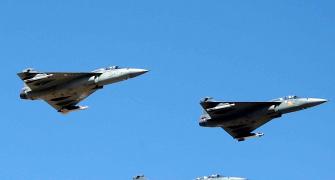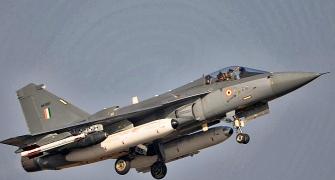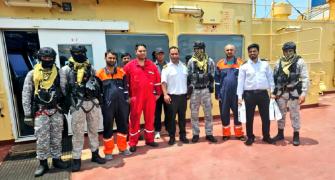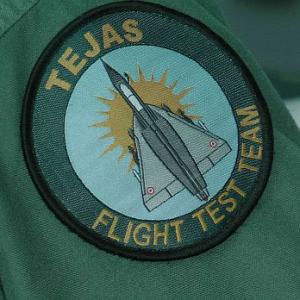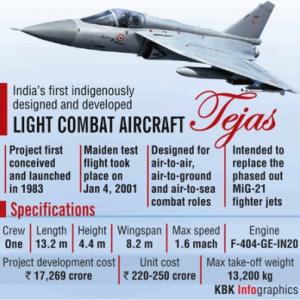India’s first home-grown fighter jet was finally inducted into the Indian Air Force on Friday after a tortuous saga spread over 33 long years with the launch of the first squadron of two Light Combat Aircraft Tejas in Bengaluru, in a major milestone in the country’s military aviation.
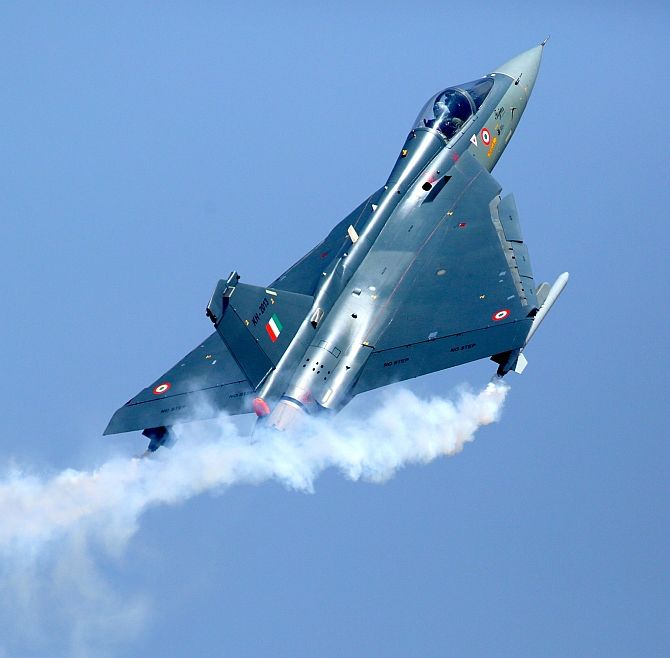
A Tejas aircraft, the fourth plus generation lightweight, multi-role supersonic single engine jet sporting the IAF colours soared to the skies, marking the raising of the first squadron of Tejas in the force at a ceremony preceded by inter-faith prayers, more than three decades after it went into development.
The LCA, smallest and lightest of its class, was flown by Commanding Officer Group Captain Madhav Rangachari for a sortie for about seven minutes at the induction ceremony and was given a water cannon salute on landing.
Prime Minister Narendra Modi hailed the induction of Tejas as a matter of ‘unparalleled pride and happiness’ and a step which illustrates the skills and strengths of Indian scientists.
‘Induction of indigenously made Tejas fighter jet into the Air Force fills our hearts with unparalleled pride & happiness,’ he tweeted.
‘I laud HAL & ADA on the induction of Tejas fighter jet. This illustrates our skills & strengths to enhance indigenous defence manufacturing,’ Modi said in another tweet.
Defence Minister Manohar Parrikar said Tejas will take the country’s air strength to new heights.
‘Moment of National pride. Indigenously developed Tejas fighter jet inducted into Air Force. Tejas will take our air strength to new heights,’ Parrikar tweeted.
State-run Hindustan Aeronautics Limited handed over two Tejas aircraft to IAF at a ceremony held at the Aircraft System Testing Establishment in Bengaluru earlier in the day.
HAL officials and Air Marshal Jasbir Walia, Air Officer Commanding-in Chief, Southern Air Command, Air Marshal Rakesh Kumar Singh Bhadauria, the deputy chief of the Air Staff and HAL chairman Suvarna Raju were present.
A ‘Sarvadharma Samaroh’ (inter-faith prayer), a practice followed by Air force during such inductions, was also held.
The two Tejas aircraft were inducted into 45 squadron of IAF, also called as ‘Flying Daggers’, which will be based in Bengaluru for the first two years before it is moved to Sulur in Tamil Nadu.
The aircraft was named ‘Tejas’ (meaning radiance in Sanskrit) by Atal Bihari Vajpayee as prime minister.
Calling it a ‘capable’ aircraft, HAL said it would be used for air to air and air to ground strikes.
Conceived as a replacement to the ageing MiG 21s, it has been designed by Aeronautical Development Agency and produced by HAL. The LCA has flown more than 3,000 sorties or 2,000 hours till date.
Citing induction of Tejas as an important moment for the IAF, Air Marshal Jasbir Wali said it is a ‘milestone’ with regard to indigenisation and self reliance.
Asked why only two aircraft formed the first LCA squadron, he said, “It is our aircraft, when we buy, we buy eight or 20. It is our aircraft, we are part of it, and it will keep coming to us.”
On Final Operational Clearance in March 2017, he said, “Yes, yes we are hopeful. This (induction) is a big milestone. After this, things will move at a rapid pace.”

Here are some things you must know about the Tejas:
* The Tejas Light Combat Aircraft is a supersonic, single-seat, single-engine multirole light fighter aircraft, which has been under development for the past three decades. It has been co-developed by the Aeronautical Development Agency in cooperation with the Bengaluru-based Hindustan Aeronautics Limited.
* Tejas will feature in combat plan of the IAF next year and will be deployed in forward bases also. IAF has said the idea is to have a total of six aircraft this financial year and about eight in the next.
* IAF plans to induct over 80 aircraft with better specifications known as Tejas 1A. The upgraded version of Tejas, with Active Electrically Scanned Array Radar, Unified Electronic Warfare Suite, mid-air refuelling capacity and advanced beyond the vision range missiles, will cost between Rs 275 crore and Rs 300 crore.

* While the idea to have an indigenous fighter aircraft was conceptualised in 1970s, actual work started on the aircraft only in the 1980s and the first flight took place in January 2001.
* The Tejas is perhaps the world’s smallest lightweight, multi-role single engine tactical fighter aircraft. As a single engined, multi-role supersonic fighter, Tejas weighs 8.5 tonnes and can carry three tonnes of weapons. The Tejas employs CFC materials for up to 45% of its airframe, including in the fuselage (doors and skins), wings (skin, spars and ribs), elevons, tailfin, rudder, air brakes and landing gear doors. Composites are used to make an aircraft both lighter and stronger at the same time compared to an all-metal design
* Tejas is an aerodynamically unstable tailless compound delta-wing configuration, optimised primarily for manoeuvrability and agility. Designed to meet the tactical requirements of a modern air force, Tejas is a multi-role aircraft capable of comprehensive air superiority and air defence roles.

* It is equipped with a modern Israeli multi-mode radar, the Elta 2032, state-of-the-art Derby air-to-air missiles to attack enemy jets, and modern laser designator and targeting pods to hit ground targets.
* The upgraded version of Tejas, with active electrically scanned array radar, unified electronic warfare suite, mid-air refuelling capacity and advanced beyond-the-vision-range missiles, will cost between Rs 275 crore and Rs 300 crore.
* Tejas incorporates a highly reliable quadruplex digital fly-by-wire Flight Control System. The new generation glass cockpit comprises Multi Function Displays, Head Up Display and Stand by Instrumentation System driven by Open Architecture Mission and Display Computer. This provides effective Human Machine Interface. The advanced utility and health management system provides system health and warnings to the pilot through a Open Architecture Computer.
With inputs from PTI


